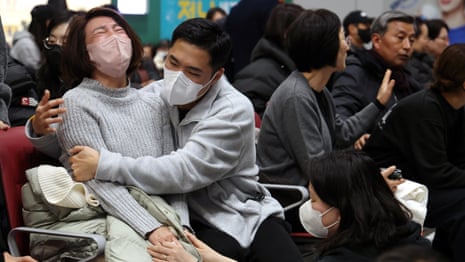‘Final tragedy’: experts debate role of concrete barriers and runway design in South Korean plane crash

Aviation experts have raised safety questions over the placement of large concrete barriers at the end of runways after a plane crashed into one in South Korea on Sunday.
The Boeing 737-800, operated by South Korea’s Jeju Air, exploded as it ploughed into the concrete embankment while making an emergency landing at Muan international airport.
While a bird hitting the engine is believed to have played a role in the initial emergency, aviation experts have said such a common phenomenon was not the only factor in the disaster, which killed all but two of the 181 people onboard.
Some have pointed to the concrete structure – nearly two metres high, and understood to be much taller than those used at other South Korean airports. The barrier also supported a “localiser” antenna, whose purpose is to provide landing alignment information to inbound aircraft.
David Learmount, a UK-based aviation safety expert, argued it was unusual and unsafe to have the localiser held by such a sturdy wall so close to the airstrip.
“That kind of structure should not be there,” he told Sky News.“Not only is there no justification, I think it’s verging on criminal to have it there.”
Crash risks and overrun
The crash risks created by structures near runways have resulted in international standards recommending a clearway of at least 90 metres and a preferred 240 metres, according to Prof Greg Bamber from Monash University’s Business School in Australia.
The embankment is 250 metres beyond the end of the runway and South Korean officials said it had been built to standard, pointing to similar structures at European and US airports.
Those standards were widely adopted by major airports, revised regularly by the United Nation’s International Civil Aviation Organization, and had seen most overrunning planes land safely, said Dr Ian Douglas, an aviation expert at the University of New South Wales.
“This was obviously the worst possible [overrun] case. Some [planes] just get stuck in the mud,” he said.
The design of runway barriers varied airport to airport, depending on their own unique surroundings, Douglas said.
Geoffrey Thomas, the editor of aviation website 42,000 Feet, said necessary equipment like localisers were not a major cause of overrun accidents.
“Look at Sydney Airport: they’ve got localisers and they’ve got all sorts of stuff at either end of the runway, and in some cases … the runway is going into the ocean,” he said.
“If an aircraft touches down where it’s supposed to touch down, then there isn’t an issue.”
Thomas highlighted that the Jeju plane flew in over the 2800-metre runway but only touched down and began to lose momentum once it was nearly halfway down the airstrip.
In the event a plane touches down late on the airstrip, like the Jeju flight, Thomas said an extended clearway may prevent it from crashing, but it would be difficult to install retrospectively.
Concrete a lifesaving material?
Douglas said an arrest space could often be installed at the end of a runway, decelerating a plane like loose gravel slows cars that run off a Formula One track.
Also in question is whether the barrier should have been constructed with an alternate material, to crumple and give way if hit by a plane.
South Korean transport ministry officials said on Monday they would look into whether the Muan airport’s localiser should have been made with lighter materials that would have broken up more easily.
The localiser followed ICA guidelines; but its installation on a wall at the end of the runway will be likely pored over in the review of the accident.
Thomas said the absence of a concrete barriermay have simply resulted in the plane crashing into the steel navigation system or into a road or ditch beyond.
“It would have hit that and the result would have been pretty much the same,” he said. “That was the final tragedy in a series of of a series of cascading errors and problems.”



